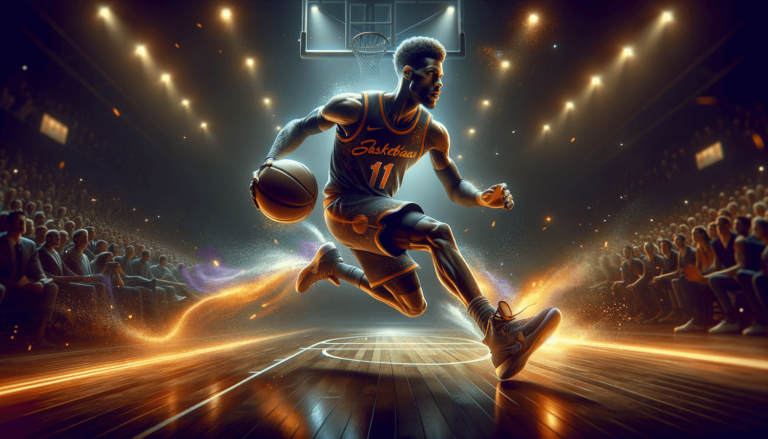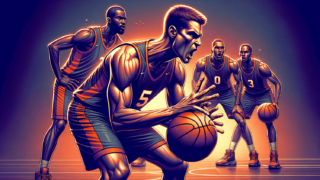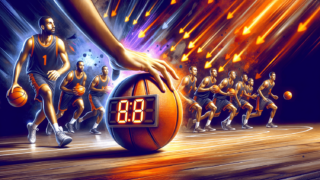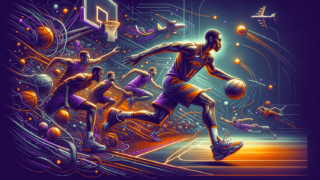
Basketball Dribbling Rule: What Constitutes a Legal Dribble?
Written by: Basketball Universe
Last updated:

As any hardwood warrior knows, the world of basketball is a thrilling arena filled with rapid changes in direction, high-flying dunks, and fast-breaks that defy gravity. But to navigate this world with finesse and flair, one skill reigns supreme: dribbling. The art of maintaining control of the orange sphere, as you creatively zigzag down the court, pivoting, and faking out opponents. However, there’s a secret pulse that beats within this ultrasonic rhythm, keeping it all in sync: the ever-important, often misunderstood, Basketball Dribbling Rule. So, lace up your kicks, smooth your palms, and get ready to bounce – it’s time to dive deep into what constitutes a legal dribble and entertain the hoops savant in all of us.
Basketball Dribbling Rule: What Constitutes a Legal Dribble?
A legal dribble in basketball is when a player bounces the ball off the floor using one hand while maintaining control over it. Key aspects of a legal dribble include keeping the hand on top of the ball, avoiding double- or simultaneous dribbling, and not carrying or palming the ball.
Mastering the Art of Legal Dribbling
The world of basketball is dynamic and full of excitement. With players breaking ankles, throwing down thunderous dunks, and raining threes from beyond the arc. However, the foundation of all these flashy moves lies in one basic, essential skill: dribbling. In this blog post, we’re going to dissect the rules surrounding dribbling and provide guidance for how to perfect a legal dribble, thereby elevating your game to new heights.
Hand Position: Staying on Top of the Game
One of the most significant aspects of maintaining a legal dribble is your hand position on the basketball. According to basketball rules, your hand must remain on top of the ball while dribbling, avoiding any attempt to carry or palm the ball. Let’s break down the difference between these terms and their implications for your dribbling technique.
Carrying the Ball
Carrying, or “carrying over,” occurs when a player momentarily places their hand under the ball, lifting it off the ground during a dribble. This action is illegal and will result in a turnover, giving the opposing team possession of the ball. To prevent carrying from happening, keep your hand on top of the ball and let your fingers provide the necessary force to control and direct your dribble.
Palming the Ball
Palming, on the other hand, takes place when a player uses their palm to grip the ball excessively during a dribble, thereby causing the ball to remain in their hand for an extended duration. This violation also results in a turnover. To avoid palming, focus on dribbling with your fingertips rather than allowing the ball to rest in your palm, enabling you to maintain control, speed, and agility.
Double Dribbling: A Rule Worth Duplicating
Another essential aspect of legal dribbling involves avoiding the notorious “double dribble” violation. Double dribbling happens when a player stops their dribble, proceeds to hold the ball with one or two hands, and then starts dribbling again. This maneuver is against the rules and will also result in a turnover.
How to Avoid Double Dribbling
The best way to prevent double dribbling is by actively engaging in decision-making when handling the ball. This involves recognizing when to pass, shoot or continue dribbling, based on the evolving gameplay. Here are some tips to help you avoid double dribbling:
- Keep your dribble alive: If you’re unsure about your next move, maintain a low, controlled dribble until you decide to pass or shoot.
- Avoid unnecessary stops: Practice analyzing the court and making quick decisions to reduce the chances of stopping your dribble on the court.
- Improve your ball-handling skills: The more comfortable you are with dribbling, the less likely you are to inadvertently commit a double dribble violation.
Simultaneous Dribbling: When Two Hands Aren’t Better Than One
While it may seem like an advantage to use both hands to dribble, the rules of basketball dictate that simultaneous dribbling is a violation. Using both hands to dribble the ball will result in a turnover, regardless of whether you’re dribbling the ball with the palms facing up or down.
Single-Handed Dribbling Tips
To stay on the right side of the rules, it’s essential to develop your ability to dribble with one hand. Here are some useful tips for practicing your single-handed dribble:
- Strengthen your weaker hand: Invest time in dribbling practice with your non-dominant hand. Building proficiency with both hands will make you a more versatile and unpredictable player on the court.
- Practice change of pace: Switching between fast and slow dribbles can help you maintain control of the ball and difficult for opponents to guard.
- Work on dribble moves: Incorporating various dribble moves like crossovers, between the legs, or behind the back can help you maintain a single-handed dribble and keep defenders guessing.
Traveling: When Feet and Basketball Rules Clash
Though not a dribbling rule per se, traveling is a violation related to a player’s movement while in possession of the ball, which often occurs during attempted dribble moves. Traveling occurs when a player lifts their pivot foot off the ground and then places it back on the floor without releasing the ball.
How to Avoid Traveling
To avoid getting hit with a traveling violation, it’s important to have a solid understanding of footwork and maintain control of your dribble. The following tips will help you steer clear of traveling:
- Establish a solid pivot foot: When you stop dribbling, plant one foot firmly on the ground to serve as your pivot foot, allowing you to rotate or change direction without committing a traveling violation.
- Master the jump stop: A jump stop involves leaping off one foot and landing on both feet simultaneously. Once you have completed the jump stop, you can set either foot as a pivot foot, granting you increased flexibility in your movement.
- Work on your footwork: Practice various footwork drills to increase your comfort and control while handling the basketball, thereby reducing the likelihood of traveling violations.
Dribbling is the backbone of basketball, and understanding what constitutes a legal dribble is crucial for players looking to elevate their game. By mastering the rules and techniques mentioned above, you’ll be well on your way to becoming a basketball maestro, ready to conquer the court and dazzle both teammates and opponents alike.
The Importance of Ball Control
Aside from adhering to dribbling rules, developing excellent ball control is crucial to becoming a more effective player on the court. Superior ball-handling and control can aid in maneuvering through tight spaces, reducing turnovers, and improving your overall offensive game. Here are some key points and drills to help you enhance your ball control:
Low Dribbling
Keeping your dribble low to the ground is vital for maintaining control and protecting the ball from defenders. Focus on dribbling below your knees; this lowers your center of gravity and makes it more challenging for opponents to steal the ball. Practice low dribbling drills to train your muscles and refine control in this area.
Use Your Body to Shield the Ball
Using your body to shield the ball is essential in maintaining control while facing defensive pressure. Position yourself between the ball and the defender, allowing your body to serve as a barrier that is not only difficult to breach, but also acts as an obstacle to potential reaching attempts. This technique is invaluable when navigating congested areas on the court.
Practice Drills for Ball Control and Handling
Regular practice sessions focused on ball control and handling can significantly improve your dribbling abilities. The following drills are examples of exercises that can help:
- Stationary dribbling: Practice dribbling in place with both hands, focusing on keeping the dribble low and controlled. Experiment with varied rhythms, speed, and heights to hone your skillset.
- Figure eight dribbling: Dribble the ball around your legs in a figure-eight pattern, alternating between your right and left hand. This drill helps improve your overall ball control and the speed at which you can change directions.
- Pound dribble: Dribble the ball as hard as possible while maintaining control at different heights (low/medium/high). This drill helps you become accustomed to dribbling with force and builds confidence in your ball-handling abilities.
- Two-ball dribbling: Dribble two basketballs simultaneously, focusing on keeping your dribble low and controlled. This drill pushes your coordination to the limit and can strengthen your ball-handling skills substantially.
Knowing When to Dribble and When to Pass
An often overlooked aspect of legal dribbling is the larger context of decision-making in the game. Knowing when to dribble and when to pass can be the difference between charging through opponents to net an easy layup, or carelessly turning the ball over. Here are a few tips to help you make the right choice:
- Evaluate the situation: Always assess the court and look for available options. If a teammate is open and has a better scoring opportunity, make the pass rather than attempting to dribble past multiple defenders.
- Anticipate defensive pressure: Recognize when and where pressure is coming from to make quicker, smarter decisions whether to dribble or pass.
- Look for mismatches: If you notice a smaller or slower defender guarding you, capitalize on this discrepancy by dribbling past them and create scoring opportunities for yourself or your teammates.
- Don’t over-dribble: Limit unnecessary dribbling to minimize the risk of turnovers and maintain the flow of the game. Remember, sometimes less is more.
By embracing these additional insights on ball control, decision-making, and the importance of knowing when to dribble and when to pass, you can elevate your basketball game and become a more versatile player on the court. As your understanding of the rules and intricacies of legal dribbling grows, so too will your on-court prowess, making you an invaluable asset to any team.
Frequently Asked Questions
If you still have questions regarding dribbling rules and techniques in basketball, you’re not alone. This FAQ section aims to address some of the most common questions related to legal dribbling, from rules to drills, to help you gain a greater understanding and confidence in your ball-handling skills.
1. Can I dribble using both hands?
No, dribbling with both hands simultaneously is a violation known as simultaneous dribbling, and it will result in a turnover. To ensure a legal dribble, use only one hand at a time.
2. What happens if I accidentally carry or palm the ball while dribbling?
Carrying or palming the ball while dribbling is a violation, and it will result in a turnover, giving possession to the opposing team. To avoid these violations, focus on maintaining proper hand positioning and technique during dribbling.
3. Can I stop dribbling and then start again?
No, stopping dribbling and then starting again is called a double dribble, which is a violation. Once you stop dribbling, you must either shoot or pass the ball to avoid a turnover.
4. How do I improve my non-dominant hand for dribbling?
Practice is the key to improving dribbling with your non-dominant hand. Incorporate drills focused on stationary dribbling, two-ball dribbling, and court-based exercises to develop balance, coordination, and strength in both hands.
5. What can I do to avoid turnovers during dribbling?
To avoid turnovers, focus on maintaining control of the ball, using your body to shield the ball from defenders, practicing low dribbling, and making quick, smart decisions on the court.
6. How can I maintain better ball control when dribbling at high speeds?
Practice dribbling at different speeds, gradually increasing the pace while still maintaining control over the ball. Focus on keeping a low dribble, utilizing your fingertips, and staying attentive to your surroundings on the court.
7. How can I practice protecting the ball from defenders while dribbling?
Concentrate on using your body to shield the ball, maintaining a low dribble, and keeping your head up to anticipate defensive pressure. Utilize drills and exercises to simulate game-like defensive situations to enhance your ball protection skills.
8. Which dribbling moves should I learn to become a better ball-handler?
Invest time in practicing various dribble moves, such as crossovers, behind the back, between the legs, and spins. These moves can help improve your ball-handling skills and make you a more unpredictable player on the court.
9. Can I jump and dribble at the same time?
No, jumping while dribbling is considered a violation and will result in a turnover. To legally dribble, maintain contact with the ground and focus on staying low and controlling the ball.
10. When should I dribble instead of passing or shooting?
Dribble when looking to create open space or maneuver around defenders, especially if there are no viable passing or shooting options. Assess the situation on the court and make quick decisions to determine whether to dribble, pass, or shoot.
Featured Posts
- No pillar pages found.





